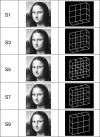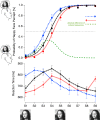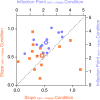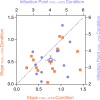Positive and negative hysteresis effects for the perception of geometric and emotional ambiguities
- PMID: 30256789
- PMCID: PMC6157843
- DOI: 10.1371/journal.pone.0202398
Positive and negative hysteresis effects for the perception of geometric and emotional ambiguities
Abstract
Aim: The present study utilizes perceptual hysteresis effects to compare the ambiguity of Mona Lisa's emotional face expression (high-level ambiguity) and of geometric cube stimuli (low-level ambiguity).
Methods: In two experiments we presented series of nine Mona Lisa variants and nine cube variants. Stimulus ambiguity was manipulated by changing Mona Lisa's mouth curvature (Exp. 1) and the cubes' back-layer luminance (Exp. 2). Each experiment consisted of three conditions, two with opposite stimulus presentation sequences with increasing and decreasing degrees of ambiguity, respectively, and a third condition with a random presentation sequence. Participants indicated happy or sad face percepts (Exp. 1) and alternative 3D cube percepts (Exp. 2) by key presses. We studied the influences of a priori perceptual biases (long-term memory) and presentation order (short-term memory) on perception.
Results: Perception followed sigmoidal functions of the stimulus ambiguity morphing parameters. The morphing parameter for the functions' inflection points depended strongly on stimulus presentation order with similar effect sizes but different signs for the two stimulus types (positive hysteresis / priming for the cubes; negative hysteresis / adaptation for Mona Lisa). In the random conditions, the inflection points were located in the middle between those from the two directional conditions for the Mona Lisa stimuli. For the cube stimuli, they were superimposed on one sigmoidal function for the ordered condition.
Discussion: The hysteresis effects reflect the influence of short-term memory during the perceptual disambiguation of ambiguous sensory information. The effects for the two stimulus types are of similar size, explaining up to 34% of the perceptual variance introduced by the paradigm. We explain the qualitative difference between positive and negative hysteresis with adaptation for Mona Lisa and with priming for the cubes. In addition, the hysteresis paradigm allows a quantitative determination of the impact of adaptation and priming during the resolution of perceptual ambiguities. The asymmetric shifts of inflection points in the case of the cube stimuli is likely due to an a priori perceptual bias, reflecting an influence of long-term memory. Whether corresponding influences also exist for the Mona Lisa variants is so far unclear.
Conflict of interest statement
The authors have declared that no competing interests exist.
Figures









Similar articles
-
How positive emotional content overrules perceptual history effects: Hysteresis in emotion recognition.J Vis. 2020 Aug 3;20(8):19. doi: 10.1167/jov.20.8.19. J Vis. 2020. PMID: 32805042 Free PMC article.
-
Mona Lisa is always happy - and only sometimes sad.Sci Rep. 2017 Mar 10;7:43511. doi: 10.1038/srep43511. Sci Rep. 2017. PMID: 28281547 Free PMC article.
-
The psychology of Mona Lisa's smile.Sci Rep. 2024 May 28;14(1):12250. doi: 10.1038/s41598-024-59782-1. Sci Rep. 2024. PMID: 38806507 Free PMC article.
-
Looking Into Mona Lisa's Smiling Eyes: Allusion to an Illusion.Front Hum Neurosci. 2022 Jul 1;16:878288. doi: 10.3389/fnhum.2022.878288. eCollection 2022. Front Hum Neurosci. 2022. PMID: 35845241 Free PMC article.
-
The psychophysics of perceptual memory.Psychol Res. 1999;62(2-3):81-92. doi: 10.1007/s004260050043. Psychol Res. 1999. PMID: 10472196 Review.
Cited by
-
Positive hysteresis in emotion recognition: Face processing visual regions are involved in perceptual persistence, which mediates interactions between anterior insula and medial prefrontal cortex.Cogn Affect Behav Neurosci. 2022 Dec;22(6):1275-1289. doi: 10.3758/s13415-022-01024-w. Epub 2022 Jul 20. Cogn Affect Behav Neurosci. 2022. PMID: 35857280 Free PMC article.
-
Presenting rose odor during learning, sleep and retrieval helps to improve memory consolidation: a real-life study.Sci Rep. 2023 Feb 9;13(1):2371. doi: 10.1038/s41598-023-28676-z. Sci Rep. 2023. PMID: 36759589 Free PMC article.
-
Recurrent processing improves occluded object recognition and gives rise to perceptual hysteresis.J Vis. 2021 Dec 1;21(13):6. doi: 10.1167/jov.21.13.6. J Vis. 2021. PMID: 34905052 Free PMC article.
-
Large EEG amplitude effects are highly similar across Necker cube, smiley, and abstract stimuli.PLoS One. 2020 May 20;15(5):e0232928. doi: 10.1371/journal.pone.0232928. eCollection 2020. PLoS One. 2020. PMID: 32433672 Free PMC article.
-
How positive emotional content overrules perceptual history effects: Hysteresis in emotion recognition.J Vis. 2020 Aug 3;20(8):19. doi: 10.1167/jov.20.8.19. J Vis. 2020. PMID: 32805042 Free PMC article.
References
-
- Rubin E. Visuell wahrgenommene Figuren Copenhagen: Gyldendals; 1921.
Publication types
MeSH terms
LinkOut - more resources
Full Text Sources
Other Literature Sources

